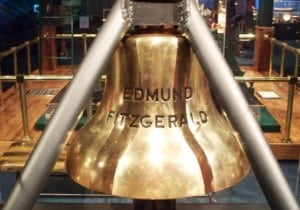Tag: Crew of the Edmund Fitzgerald
Keener Remembers The Twenty Nine
“The legend lives on from the Chippewa on down of the big lake they call Gitchee Gumee..”
Nearly every member of the Keener Generation can vividly recall the opening of Gordon Lightfoot’s most successful recording, a cautionary tale about the awesome power of Mother Nature and the fate that befell the 29 men who were caught in her turbulent grasp 40 years ago today.
They were fathers, brothers, husbands, by all accounts, good men, tough and hard-working men, who sailed the Great Lakes on an ore-carrier.
Edward Sherman, then a young man in Door County, Wisconsin, remembered the weather that day. “It was a lot like the hurricanes that I later experienced in Florida.” The storm would become one of the worst to be recorded in the history of Lake Superior, sending what was then the biggest ever vessel that traversed her to the bottom.
It’s been 4 decades since the S. S. Edmund Fitzgerald slipped beneath the churning waves. It happened shortly after 7:10pm, near Superior’s southernmost point, only a few miles away from the safety of Whitefish Bay.
She was the pride of the shipbuilders at the Great Lakes Engineering Works in River Rouge when she was christened in 1958. Chris Gillcrist, Executive Director of the National Museum of the Great Lakes, told Toledo, Ohio’s abc13, “They built bigger boats after her but she continued to break seasonal tonage records because she ran long and she carried a lot. She started work early in the season and she was never laid up.”
The sheer size of the Edmund Fitzgerald made her a tourist attraction. “I can still picture it sitting here being overwhelmed by its size,” remembers former Toledo Blade editor, Tom Walton. “It was longer, bigger and faster than any other ship out there.”
Her ultimate destination was the Detroit Ironworks on Zug Island, near Ford’s mammoth River Rouge complex. Her cargoes were forged into automobiles, construction material and the sturdy iron skeletons of enduring edifices that could stand tall against the worst of Superior’s legendary squalls.
But on that November night, as “the ship’s bell rang.” nothing could protect The Edmund Fitzgerald from her inexorable fate.
The weather forecasts that day predicted 10 foot waves and winds peaking at a manageable 36 knots. But then, as now, divining the behavior of the swirling pressure systems that spawn “the gales of November” was was in inexact science. Captain Ernest McSorley had no reason to believe the trip would be any different from the dozens of November runs he had made during his career.
As the morning of November 10th dawned, the weather service upgraded the forecast, the Soo Locks were closed and ships on the big lake were encouraged to seek shelter.
The storm had shut down the navigational aids at Whitefish Bay. The powerful winds, the worst that Captain McSorley had ever experienced, disabled both of the Edmund Fitzgerald’s radar systems, torw a railing from it’s moorings and destroyed two crucial vent covers. The heavy seas flowing over her decks made it impossible for the ships 6 bilge pumps to keep ahead of the water that was pouring in.
Throughout the storm, Captain McSorley had been in contact with another vessel, the Arthur M. Anderson. It’s skipper, Bernie Cooper, made the last radio contact with McSorley. With wind gusts now raging near 80 knots, the doomed Captain reported, “We are holding our own.”
Just minutes later, the great ship disappeared from the Anderson’s radar screens. No distress signal was ever received.
One year later, Captain McSorley’s step daughter was driving through Toledo, Ohio, when she heard Gordon Lightfoot’s classic composition for the first time. “I had to pull off the road,” Nancy Ulrich told the Toledo Blade. “I was so overcome with emotion. I think it’s beautiful, a tribute to dad, to all the men on the ship and to their families.” Soon thereafter, a package appeared on Ms. Ulrich’s front porch. It was a copy of the album, with a personal message from Lightfoot himself.
May the souls of the 29 Rest In Peace, honored by a generation’s love for the artistry of a Canadian folksinger and forever a part of the eternal splendor of the Great Lakes.
Read more coverage of the story in The Detroit News and The Detroit Free Press. Visit the memorial Facebook Page. And learn more about the song here.



